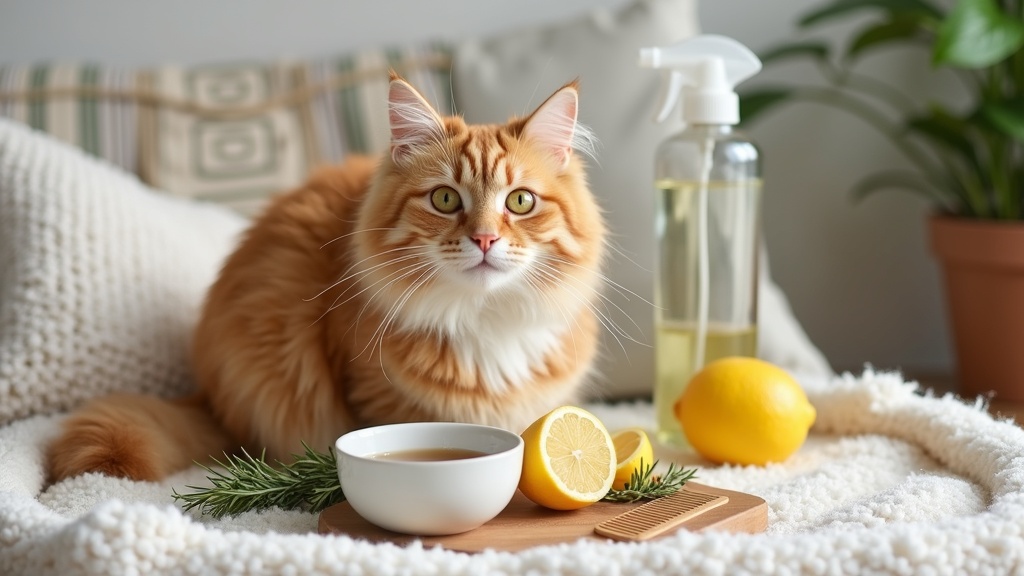If you have a cat, you probably know the struggle with fleas all too well. These little bugs can take over bedding, carpets, and even your own skin before you realize it. A lot of flea treatments are packed with chemicals that some pet owners would rather avoid, especially for cats that groom themselves and might end up swallowing something they shouldn’t. If you’re looking for an all natural flea repellent for cats, I’ve got some tried and true options worth checking out, along with tips for using them safely around your furry buddy.

Understanding Natural Flea Repellents for Cats
Choosing a natural flea repellent means putting your cat’s health first, while also tackling the headache of fleas in your home. Flea infestations aren’t just annoying; they can leave your kitty scratching like crazy, dealing with biting, and even getting sick from tapeworms or anemia. With natural options, it’s all about finding ingredients that send fleas packing, but are still safe if your cat happens to lick or roll in them.
Not every home remedy out there is safe for cats. Some essential oils and common kitchen items, such as garlic, can do more harm than good. That’s why keeping things simple, gentle, and well researched makes all the difference. Below, I’ll walk you through what I’ve learned to help keep those fleas at bay, without exposing your cat to harsh chemicals.
Top Natural Flea Remedies You Can Try
There’s a pretty healthy list of options to test out, depending on what you’ve got at home and what your cat tolerates. Here’s a breakdown of the all natural flea repellents that have stood the test of time in cat households:
- Cedar chips: Fleas can’t stand the smell of cedar. Sprinkling cedar chips in your cat’s bedding or around the garden makes a simple flea barrier. A big reminder: skip the cedar essential oil. If your cat ingests it while grooming, it can be toxic.
- Lemons: Lemons are a natural source of citric acid, which is great for killing fleas. To make a lemon flea spray, slice up a lemon, steep it in boiling water, strain, and let it cool. You can spray it on cat bedding or add lemon juice to your laundry loads for anything your cat naps on. Never apply lemon directly to your cat’s fur.
- Rosemary and cumin: Rosemary can be ground into a powder and sprinkled on carpets and bedding. You can also steep rosemary in water to make a mild spray. As for cumin, a small amount (less than a teaspoon) mixed into your cat’s food can help repel fleas naturally, since fleas dislike the taste when it shows up on your kitty’s skin.
- Salt: Regular table salt dries out fleas and their eggs. Sprinkle it onto carpets, let it sit for a day, and vacuum up. You can even mix it with water to help clean bedding.
- Apple cider vinegar (ACV): ACV won’t kill fleas, but it repels them. Mix two parts ACV and one part water in a spray bottle, spritz lightly on your cat’s coat, and avoid the face. You might have to repeat this every few days for best results.
- Dish soap: A mild, unscented dish soap (like basic blue Dawn) breaks down flea exoskeletons, killing them fast. When you bathe your cat, lather with diluted dish soap, rinse well, and towel dry. Don’t overdo it, because dish soap can dry out kitty skin. You can also try the flea trap trick: set out shallow dishes filled with soapy water and shine a lamp above to attract and drown fleas overnight.
- Lavender and chamomile: Steep fresh lavender or a chamomile tea bag in water, let it cool, then spray or dab gently onto your cat’s fur (avoiding the eyes and face). Lavender and chamomile not only repel fleas, but they’re also soothing for itchy, irritated skin and can calm a frazzled cat after dealing with pests.
- Coconut oil: This one smothers fleas, soothes itchy red skin, and can even help your cat’s fur stay soft. After bathing your cat, rub a teaspoon or so of coconut oil through their damp coat. Let it sit for a few hours, then rinse and brush out the residue and dead fleas. Don’t let your cat ingest large amounts; just a very light layer is plenty.
- Flea comb: A flea comb is a super handy, chemical free tool. Run the finetoothed comb through your cat’s fur daily. Keep a nearby bowl of soapy water to dunk any fleas you catch so they can’t jump back onto your cat. The comb helps with shedding too.
- Oregano oil: Oregano oil contains carvacrol, which bugs despise. Mix one teaspoon of oregano oil with three teaspoons of olive oil. Apply a tiny amount to flea problem areas, like ear tips, the base of the tail, and behind the neck. Use it sparingly and keep it away from spots your cat could lick easily.
Important Safety Tips with Natural Flea Remedies
Even though these options skip the heavy duty chemicals, it’s still super important to use them smartly. Some natural ingredients, like certain essential oils or spices, can be toxic to cats if used wrong. Talking with your vet before trying any homemade remedy is always a wise move. If you’re ever unsure, stick with options you know are cat safe, like flea combs, diluted apple cider vinegar sprays, and shallow soapy water traps.
- Avoid essential oils and garlic: Most essential oils and all garlic are dangerous to cats, even in small doses.
- Watch your cat’s behavior: If your cat seems uncomfortable or shows allergic reactions (excessive scratching, drooling, hiding, or acting weird), rinse off any products and call your vet.
- Dilute everything well: Cat skin is way more sensitive than ours. Always dilute sprays and oils, and avoid eyes, nose, and open wounds.
- Keep food portions tiny: Even with friendly seasonings like cumin, stick with less than one teaspoon for an average adult cat. Always check with your vet before offering anything new in food.
Spotting Fleas and Flea Hotspots Around Your Cat
Kittens and older cats are usually the first to show signs of flea trouble, but any cat can get hit. Keep an eye out for:
- Constant scratching or licking, especially at the base of the tail, belly, and neck
- “Flea dirt”, little black specks that look like pepper on your cat’s skin or bedding (it turns red when wet, since it’s really flea poop made of blood)
- Visible fleas on the fur, especially in warm spots like ear tips, underarms, groin, and around the neck
- Bites or itchy spots on humans (usually ankles and legs)
Warm, protected areas on your cat, such as ear folds, tail base, groin, and underarms, are flea hangouts. Make sure to check these areas regularly, especially when spring and summer kick in. It’s a good move to get into the habit of inspecting your cat at least once a week during flea season. The sooner you spot fleas or their telltale dirt, the easier it is to stop an infestation before it snowballs. If you live in a warm climate where fleas thrive all year, keep up your checks every few days. This extra step saves your cat a lot of itching and keeps your home more peaceful. Setting up a little routine with treats after each check can even make your kitty start looking forward to inspection time.
What to Do If Fleas Are Already in Your Home
When fleas have moved in, a single remedy might not be enough. A combo of treatments is usually the best bet:
- Start with the cat: Bathe if possible, then use coconut oil or a flea comb while the fur is still damp. Rinse and towel dry after a few minutes.
- Treat the bedding: Wash everything your cat naps on using hot water, lemon, or vinegar in the laundry.
- Sweep and vacuum: Daily vacuuming removes eggs and adults. Sprinkle salt or ground rosemary on carpets before vacuuming for an extra punch.
- Spot treat with ACV, lemon spray, or herbal powders: Focus on bedding, cat trees, and areas where your cat sleeps most.
- Set up flea traps: The dish soap trap is a classic. Fleas are drawn to the light and warmth, hop in, and drown; super effective for overnight control.
Common Questions About Natural Flea Control for Cats
Cats are sensitive creatures, so I get loads of questions from friends and readers about using home flea treatments safely. Here’s what comes up most:
Q: Can I use essential oils on my cat to get rid of fleas?
A: It’s better to avoid most essential oils unless you’re working with a very, very diluted solution, and never let your cat lick or ingest them. Some oils, like tea tree, are very dangerous for cats. Stick with safer options like fresh lavender or diluted rosemary water.
Q: Is it safe to feed my cat something to repel fleas?
A: Some small amounts of cumin are considered safe and can help, but avoid all garlic, onions, or anything spicy. Always ask your veterinarian first if your cat has health concerns.
Q: Do home remedies actually work for flea control?
A: A lot of families find real success with regular grooming, herbal sprays, and coconut oil, especially when combined with cleaning and vacuuming. If your cat has a heavy flea load, you might need to use these remedies alongside help from your vet until things get under control.
Wrapping Up
Natural flea repellents can make a huge difference in your cat’s comfort and your home’s cleanliness. Whether you try cedar chips, ACV sprays, or just become a pro with that flea comb, every cat is a little different, so mix and match and watch for what gets your kitty purring again. Just make sure to put safety first, work closely with your vet if you’re unsure, and keep up with cleaning home hot spots for the best results. A healthy cat and a flea free couch are totally possible with the right approach!



